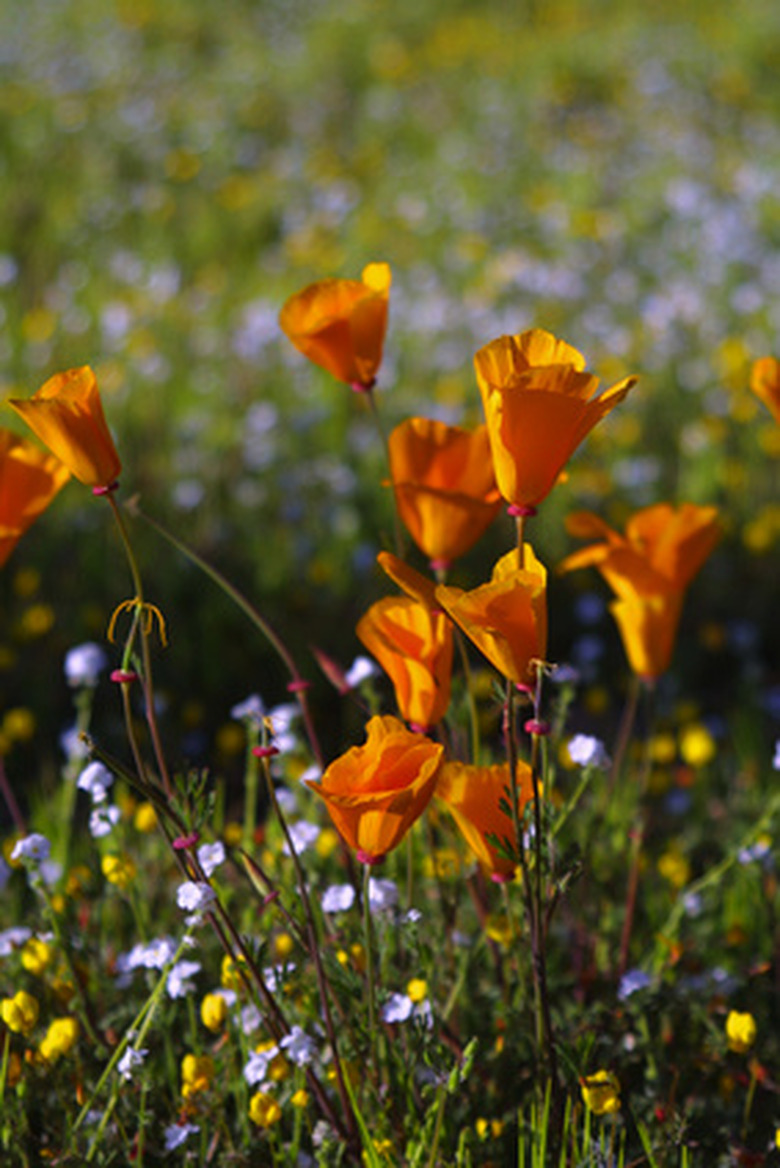Examples Of Insect Pollinated Flowers
Different insect-pollinated flowers have different adaptations to lure potential pollinators, according to San Francisco State University. Flowers dependent upon bee pollination are usually blue or yellow–bees don't see red–with narrow tubes containing sweetly scented nectar and markings to guide the bees to it. Some, like snapdragons, have petals that allow only bees of the correct weight access to the nectar. Some plants, however, welcome a variety of insects.
Great Blue Lobelia
Great blue lobelia (Lobelia siphilitica) is a 2- to 3-foot bellflower family perennial. Its spires of clear lavender-blue, bloom mid-summer to autumn, in light woodlands and marshes from New England south to Alabama and west to Wyoming. The flowers attract both bees and hummingbirds, according to the Lady Bird Johnson Wildflower Center. This obliging–but drought-intolerant– perennial will grow in sun or shade and any moist clay, loam or sandy soil. Note that ingesting large amounts of the plant may be toxic.
- Different insect-pollinated flowers have different adaptations to lure potential pollinators, according to San Francisco State University.
- Flowers dependent upon bee pollination are usually blue or yellow–bees don't see red–with narrow tubes containing sweetly scented nectar and markings to guide the bees to it.
Lemon Beebalm
A fragrant mint family herb, lemon beebalm (Monarda citriodora) has foliage that emits a distinctively lemon-like aroma when crushed. Beginning in May–and continuing into early fall with regular watering–its 12- to 24-inch stems have showy spikes of tufted, lavender or pink blooms. Its nectar attracts both bees and butterflies, according to the Lady Bird Johnson Wildflower Center. Large colonies of the wild plants thrive on loamy prairie soils or rocky slopes from Kentucky west to Kansas and across the Southwest. The annual plant grows in dry locations with sun to partial shade.
Common Evening Primrose
A favorite destination of the Sphinx moth, evening primrose (Oenothera biennis) may reach up to 8 feet tall. Its red or pale green downy stems have 8-inch, lance-like leaves. From mid-summer to early fall, stem-topping flower clusters appear. Blooms consist of four yellow petals, surrounded by a center of showy stamens. Flowers are open between dusk and the following morning. Its faint lemon fragrance draws bees and butterflies as well as the moth. The plant is biennial–producing roots and leaves during its first year before flowering and dying in its second–according to the Lady Bird Johnson Wildflower Center. It grows in sun or shade and dry, sandy or rocky soil.
- A fragrant mint family herb, lemon beebalm (Monarda citriodora) has foliage that emits a distinctively lemon-like aroma when crushed.
Callifornia Poppy
Both honey bees and beetles pollinate California's state flower, the California poppy (Eschscholzia canifornica). This long-blooming perennial thrives in infertile mountainside soils throughout California, where it grows from 1- to 2-feet high. It has long stems with single, yellow or orange blooms. Flowers are most abundant from March to May, according to the Lady Bird Johnson Wildflower Center. With regular water, however, they may begin appearing in February and continue into October. They contrast attractively with the plants' greenish-blue foliage. California poppy grows in sunny, well-drained locations. Ingesting it may be toxic.
- Both honey bees and beetles pollinate California's state flower, the California poppy (Eschscholzia canifornica).
- This long-blooming perennial thrives in infertile mountainside soils throughout California, where it grows from 1- to 2-feet high.
